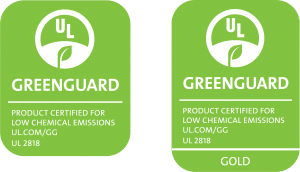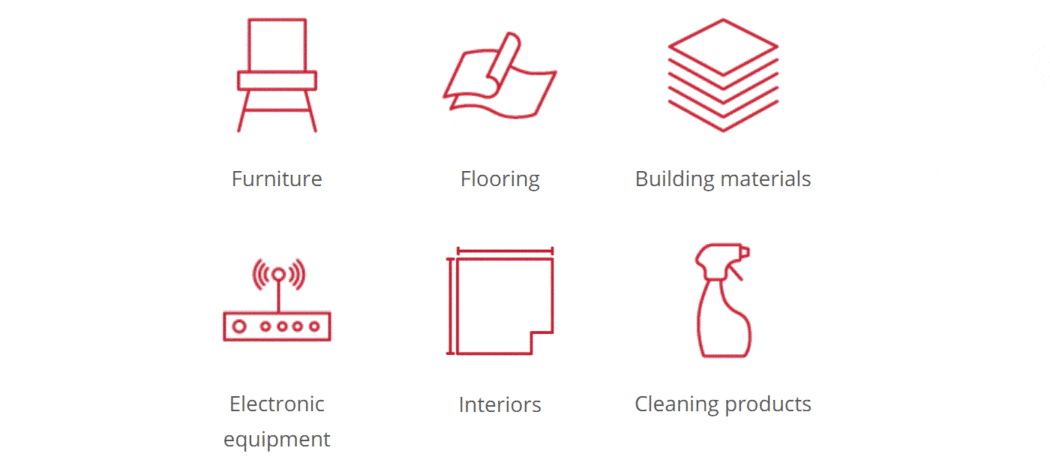In this post-pandemic era, our homes and indoor spaces serve as our safe places — areas where we can seek refuge, relaxation, and rejuvenation. Yet, chemicals and pollutants are inadvertently invited in by our choice of furniture, decor, and even toys. The growing demand for health-conscious and eco-friendly home products speaks volumes about our collective drive to protect our families and the planet. But how can we truly ensure the items we bring into our homes align with these values?
This is where certifications like Greenguard step in. With rigorous standards on chemicals and VOCs, Greenguard certified products help ensure that our product choices are safe for ourselves and our loved ones.
Keep reading to learn more about what Greenguard certified products promise and why the investment is worth it.
What Does Greenguard Certified Mean?
Greenguard Certified is a recognition given to products that meet minimal chemical emission limits, thereby reducing indoor air pollution and the adverse health effects associated with it. UL Environment, a global independent safety science company with a century-long legacy, requires Greenguard Certified products to undergo rigorous testing to ensure their environmental and health safety.
But what exactly does UL Environment look for in Greenguard certified products? The UL team closely examines the products for volatile organic compounds (VOCs), which are chemicals that can evaporate into the air under normal conditions. VOCs can negatively impact indoor air quality, leading to health concerns like headaches, throat irritation, or even more serious ailments with prolonged exposure (1). Beyond VOCs, UL Environment also checks for other harmful chemicals that could be emitted into the indoor environment.
Furthermore, UL Environment ensures that Greenguard Certified products undergo regular testing and verification in dynamic environmental chambers, simulating real-world scenarios to truly understand the impact these products might have in a typical indoor setting.
For consumers, this meticulous level of inspection and validation means peace of mind. When you bring a Greenguard Certified product into your home or workplace, you can be confident that the products you’ve chosen meet or exceed standards for low emissions, contributing to a healthier living or working environment.
Does Greenguard Mean Non-Toxic?
While Greenguard certification ensures that a product meets strict chemical emission limits, it does not guarantee that the product is entirely free of all toxins.
Greenguard standards are focused on the amount and type of VOCs a product emits into the indoor environment. The goal is to reduce these chemicals and thereby minimize your risk of health concerns from poor air quality. The standards set by UL Environment for this certification are based on established criteria from key public health agencies.
In contrast, “non-toxic” is a broad term that implies a product does not contain any substances in amounts capable of causing harm. While Greenguard minimizes the risk for VOCs, it does not examine other types of harmful substances and chemicals. To ensure product safety, it’s always advisable to review the item’s materials and components, especially if it is intended for spaces frequented by vulnerable groups like children or the elderly.
The Importance of Greenguard Certification
For individuals who place a premium on indoor air quality—especially within residential and professional settings—Greenguard certification is paramount.
Indoor air quality has become an ever-pressing concern in modern times. As homes and offices become more energy-efficient, they also become more sealed off from the outside environment, leading to what many term as “sick building syndrome” (2). This phenomenon is where pollutants get trapped indoors, sometimes causing health concerns for the occupants.
Everyday products, from furniture and office equipment to building materials and cleaning products, can emit volatile organic compounds (VOCs) and other pollutants. Over time, these can accumulate and adversely affect indoor air quality. In fact, according to the U.S. Environmental Protection Agency, indoor air can be two to five times more polluted than outdoor air (3).
This is where the Greenguard certification plays a pivotal role. By setting stringent chemical emission standards for products, it ensures that certified items contribute significantly less to indoor air pollution. For households with children, the elderly, or individuals with respiratory issues, this certification offers an additional layer of protection and assurance.
Is Greenguard Necessary and Is It Worth It?
Is Greenguard necessary?
Greenguard certification isn’t mandatory for product purchases, but it’s highly beneficial for healthier indoor spaces. This is especially important for individuals with sensitive respiratory systems, like young children, the elderly, and those with health issues.
Is Greenguard worth it?
Absolutely, especially for those who prioritize health and the quality of the indoor environment.
Here’s a breakdown to help you understand if Greenguard is worth it to you:
PROS
- Health Benefits: Greenguard certified products ensure minimized chemical emissions, thus promoting better air quality indoors. This is particularly beneficial for households with children, older adults, or individuals with respiratory challenges.
- Eco-Friendly: Greenguard certified products are not only healthier, but more sustainable. Products with this label have met stringent environmental criteria, including reduced chemical usage and a smaller carbon footprint.
- Transparency: With Greenguard, you’re not just taking a brand’s word for it. Greenguard certified products undergo rigorous testing by an independent third-party entity, ensuring that they live up to their claims.
CONS
- Cost: Often, Greenguard certified products come with a higher price tag. This can be attributed to the rigorous testing processes and the sustainable practices employed in their production.
- Availability: Not all product categories or brands offer Greenguard certified options, which might limit choices for consumers.
While Greenguard certification isn’t a strict necessity, it’s a clear indicator of a product’s commitment to both health and the environment. If your budget allows, seeking out Greenguard certified products is a wise investment in your long-term well-being.
Key Benefits of Greenguard Certification
The primary benefits of Greenguard certification are better indoor air quality, reduced exposure to harmful chemicals, and the guarantee that a product is environmentally conscious.
Let’s dive deeper into these benefits:
- Improved Indoor Air Quality: Greenguard certified products release fewer volatile organic compounds (VOCs) and other pollutants. This means cleaner air in homes and offices, which is essential given that we spend a significant chunk of our lives indoors. Clean indoor air can reduce risks of allergies, respiratory issues, and other health problems (4).
- Reduced Exposure to Harmful Chemicals: The rigorous testing for Greenguard certification ensures that products have minimal chemical emissions. This translates to a lower risk of side effects from harmful chemicals.
- Eco-Friendliness: Beyond just health, Greenguard certified products also ensure sustainable practices in their production and design. This means reduced harm to the environment, be it in the form of decreased chemical waste or sustainable sourcing.
- Peace of Mind: Knowing that a product has been scrutinized and certified by an independent body provides consumers with an added layer of trust. There’s an assurance that the product you’re bringing into your space is safer for you and the environment.
With Greenguard certified products, you know exactly what you’re getting when it comes to healthier air for you and your family.
Greenguard vs. Greenguard Gold: The Differences

When it comes to comparing Greenguard and Greenguard Gold products, nuance is key. Both certifications ensure that products improve indoor air quality, but the Greenguard Gold certification is much more stringent.
- Stricter Standards for Gold: Greenguard Gold certified products not only meet the base Greenguard requirements but surpass them. This means they emit even fewer volatile organic compounds (VOCs) and are deemed safer for sensitive individuals, such as children and the elderly, when compared to products that are only Greenguard certified.
- Specialized Environments: While Greenguard certified products are suitable for most indoor environments, Greenguard Gold takes into account the specific needs of places like schools and healthcare facilities. The products certified under the Gold standard are especially recommended for these spaces due to the increased vulnerability of their occupants.
- Number of Chemicals Screened: Greenguard Gold tests for over 360 VOCs (5). Of those, Greenguard Gold has stricter limits for more than half when compared to the standard Greenguard certification.
While both certifications offer an added layer of assurance, Greenguard Gold ups the ante, providing a gold-standard (pun intended) for health and environmental safety.
Greenguard Certified Products & Brands
Though you may not have noticed it, you have likely come across a wide array of Greenguard Certified products. Here are a few product categories where Greenguard certification is common:

- Furniture: Perhaps one of the most prominent categories, many furniture pieces — from office chairs to bedroom sets — are Greenguard certified. Brands like Herman Miller, Steelcase, and La-Z-Boy are just a few that offer certified options.
- Flooring: Seeking out a new look for your floors? Brands like Shaw Floors and Armstrong Flooring provide Greenguard-certified options, ensuring that your new laminate, vinyl, or hardwood isn’t compromising your indoor air quality.
- Paints and Finishes: A fresh coat of paint can transform a room, but with the wrong product, it can also introduce a slew of chemicals into your space. Thankfully, companies like Benjamin Moore and Sherwin-Williams offer Greenguard certified paints, allowing for beauty without the chemical burden.
- Building Materials: From insulation to drywall, the very building blocks of our homes and offices can either be a source of chemical emissions or a safeguard against them. Brands such as Georgia-Pacific and Owens Corning have certified products designed to create healthier living and working environments.
- Electronics: It might surprise you, but even some electronics, especially those with plastic components, can emit VOCs. Brands like Dell and LG have certain products that are Greenguard certified, signaling their commitment to cleaner tech.
- Baby and Children’s Products: Considering the sensitivity of young ones, many parents prioritize eco-friendly options for their children. Brands like DaVinci Baby and Babyletto offer Greenguard certified cribs, changing tables, and dressers.
- Mattresses and Beddings: A restful night shouldn’t come with chemical concerns. Brands such as Tempur-Pedic and Sealy ensure that some of their mattress lines adhere to Greenguard standards.
Greenguard’s reach is vast and varied. The next time you’re shopping, take a moment to check for the Greenguard logo. It’s more common than you might think, and it’s a straightforward indicator of a product’s commitment to environmental and health standards.
Navigating the Market
With so many options at our fingertips, the onus is on the consumer to research products that align with their health and sustainability goals. Looking for objective third-party certifications, like Greenguard, can quickly clear up some of the ambiguity. Always look for the official Greenguard label on the product or its packaging. A visit to UL Environment’s website can further verify if a product or brand is indeed certified. Remember, genuine certifications won’t shy away from visibility.
When comparing products, beware of vague or overly generic terms like “eco-friendly,” “green,” or “all-natural” without any certifications or ingredients to back them. Real sustainability is measurable and verifiable. Always dig a little deeper and ask for the specifics. Where there’s transparency, there’s usually truth.
Though it may take a bit more time and research, the investment you’re making is worth it. When consumer demand is directed towards responsible options, the market responds, leading to broader change.
References
- “Volatile Organic Compounds’ Impact on Indoor Air Quality.” EPA, 2023. https://www.epa.gov/indoor-air-quality-iaq/volatile-organic-compounds-impact-indoor-air-quality
- “The sick building syndrome.” NIH, 2008. https://www.ncbi.nlm.nih.gov/pmc/articles/PMC2796751/
- “Indoor Air Quality.” EPA, 2023. https://www.epa.gov/report-environment/indoor-air-quality
- “Clean Indoor Air Benefits Everyone.” White House, 2022. https://www.whitehouse.gov/ostp/news-updates/2022/12/08/clean-indoor-air-benefits-everyone/
- “UL GREENGUARD Certification.” UL Environment. https://www.ul.com/services/ul-greenguard-certification




